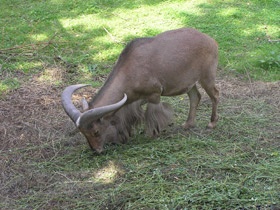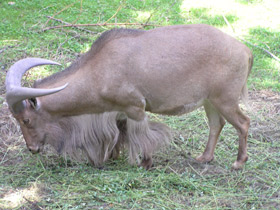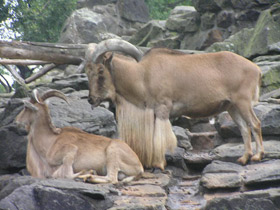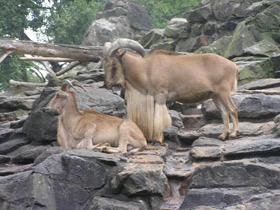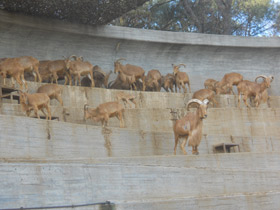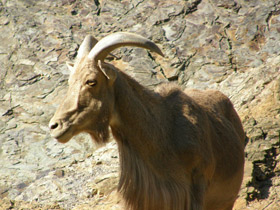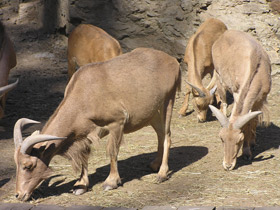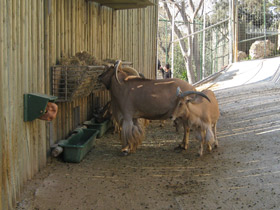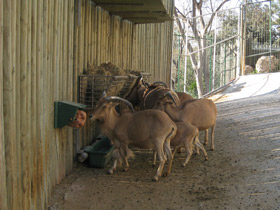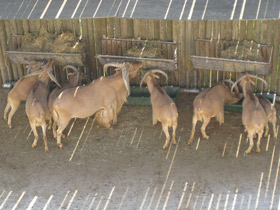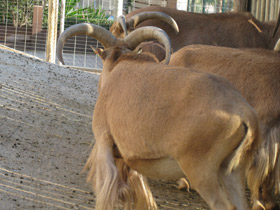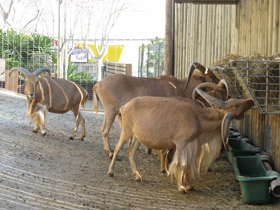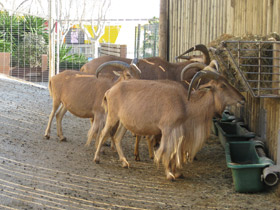The Barbary sheep Ammotragus lervia
In appearance, the Barbary sheep is somewhat of an intermediate between a sheep and a goat. Barbary sheep have a body length between 1.3 and 1.7 m with the length of the tail of 15-25 cm, and stand 75 to 110 cm tall at the shoulder. Males weigh between 100 and 145 kg, the weights of the females range from 40 to 55 kg. The coat of the Barbary sheep has a sandy-brown or reddish-tawny colour but the chin, throat, chest, and insides of the front limbs are covered with long, white hair. The short tail, which is hairless on the underside, has scent glands responsible for the “goaty” smell of this sheep. The coat is short, thick, and bristly. Both sexes have a ventral mane of long, soft hair on the throat, although in males the mane extends down the neck to encompass the chest and upper front legs. The Barbary sheep has elongated head with large eyes and small ears. Both males and females have horns that sweep backwards and outwards in an arch; the horns of the males are much larger and may reach a length of 85 cm. The Barbary sheep is found in northern Africa, where it is distributed from Morocco and Western Sahara, east to Egypt and Sudan. These sheep inhabit deserts and semi-deserts and tend to live in rocky, rugged arid areas. The Barbary sheep is the best rock climber among all mountain sheep; it is agile and can skilfully climb up steep slopes, jump down from the rocks or jump up vertically as high as 2 meters. When threatened, the Barbary sheep would not flee but stay still on site. Like many other inhabitants of deserts, the Barbary sheep are active primarily at dusk, dawn and during the night. This sheep live in small groups, comprising a single adult male, several adult females, and their offspring. The males must earn their position as head of a group of females through savage fights in which two males clash horns and sometimes try to bring the head of the competitor to the ground. Barbary sheep eat a wide variety of plant matter including grasses, lichens, and shrubs (over 79 plant species in total). Their diet varies depending on the season: in winter, grasses and forbs comprise 86% and 11% of the diet, correspondently; in spring, summer, and fall the shrubs comprise 60% of the diet, and grasses, 26%. When fresh water is not available, Barbary sheep can survive for long periods by licking off dew of leaves and grass. However, when water is available they utilize it for both drinking and bathing. Mating can occur at any time of the year but it usually peaks in autumn. The females can get pregnant as early as at 8 months of age but normally reach sexually maturity at the age of 15 months. Due to the competition with older rams, young males do not breed until they are three years old. Gestation in females lasts 150 to 165 days. One or two young (rarely three) weighing 4.5 kg are born in a secluded site in shallow rock depressions, hardly accessible for predators. In the years when food is abundant, females usually give birth to twins. The newborn are able to jump on the rocks by the end of the first day of their lives. The lambs start eating grass in a week but they are not weaned until they are 3 to 5 months old. The lambs start growing their first teeth at the age of three weeks.
Since ancient times, Barbary sheep have been hunted by local people who use them as an important source of meat, wool, skins, and tendons. Poaching with firearms and loss of habitats resulted in dramatic decline of the population sizes and this species is included in the IUCN Red List of Endangered Species as vulnerable.

















